There's a seed shortage in Washington state. What does that mean for our beloved forests?
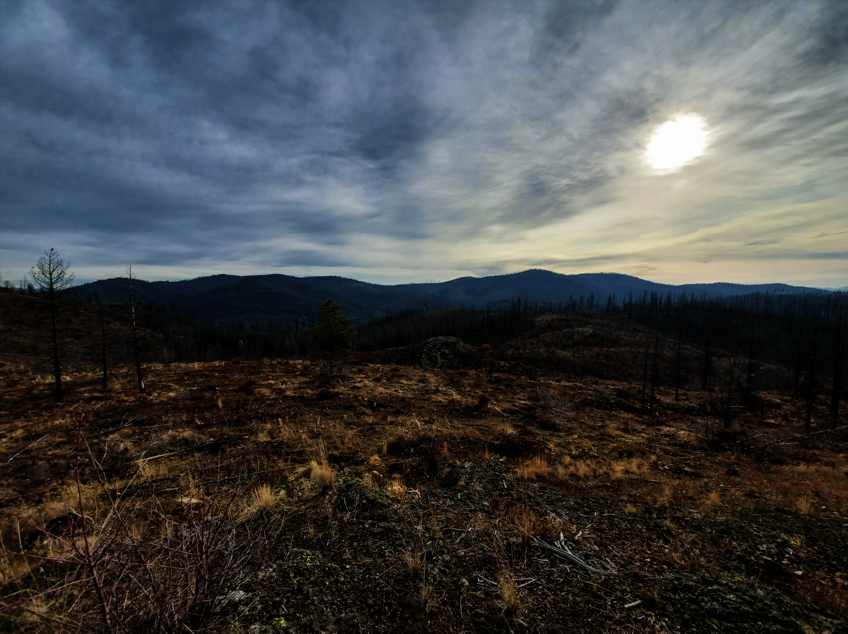
Nearly half of Washington state is forested. That's 22 million acres of Douglas firs, red alders, western hemlock, and ponderosa pine, to name a few.
But as wildfires grow in size and regularity, those millions of acres are going up in flames. Normally, there's an ecosystem of public and private tree nurseries that reseed our forests.
But a seed shortage now threatens their future.
I
n the 1990s, an average of 86,000 acres burned each year across the United States. At one time that might have sounded immense. But in the last decade, Washington state and the Western U.S. have seen their biggest fires in history, totaling hundreds of thousands of acres. Last year, California became the first state to have a single fire burn more than 1 million acres.
Between preparation in the spring and prevention through the summer and fall, wildfires have captured our attention for most of the year. But after the wet winter months roll in and the cinders cool, an important stage in our forests' lives begins: recovery.
Where the wild things grow
Recovery starts in an unassuming lot in Tumwater, just off of I-5.
The Webster State Forest Nursery looks as you'd imagine it — acres of young tree seedlings poking through the mud, rows of greenhouses brimming with new forest life.
Sponsored
This nursery is the nexus for all our forest needs. When private lands get cleared for timber, the nursery is selling seedlings to regrow those plots. When wildfires burn across the state, the nursery provides seeds to help jump-start new growth. Or maybe you just want a single tree for your front yard — you can buy that seedling here.
"We're producing 8 to 9 million trees a year," said nursery manager Brian Morris. "Not all of them make it at the end of the day. We do our best to be as efficient as possible and make sure that we get as many good trees as possible."
Nine million might sound like a big number, but as wildfires grow, it's beginning to look smaller and smaller. In December 2021, the Department of Natural Resources announced that to keep up with the growing demand, the nursery would need to more than double its production, from 9 million seeds per year to 20 million. And the solution might seem obvious at first: just make bigger orchards to grow more seeds.
But the system behind our seed economy isn't so simple.
"[Seeds] are all location specific," Morris said. "So we have woods-run, wild collected seed. Foresters go out into the woods and find trees in the area that they need seed for, that meet disease, resistance, growth characteristics. We'll climb the trees and collect cones in the woods."
Sponsored
State foresters spend a lot of time climbing trees to hand-pick pinecones. Which doesn't seem like the most efficient method. But it isn't just about the volume of seeds gathered — it's also about something Brian calls "genetic integrity."
For new trees to have the best chance of survival, they need to come from the area they're being planted in. You can't just put any ponderosa pine in a specific region of the East Cascades — that pine's parents need to be from that region.
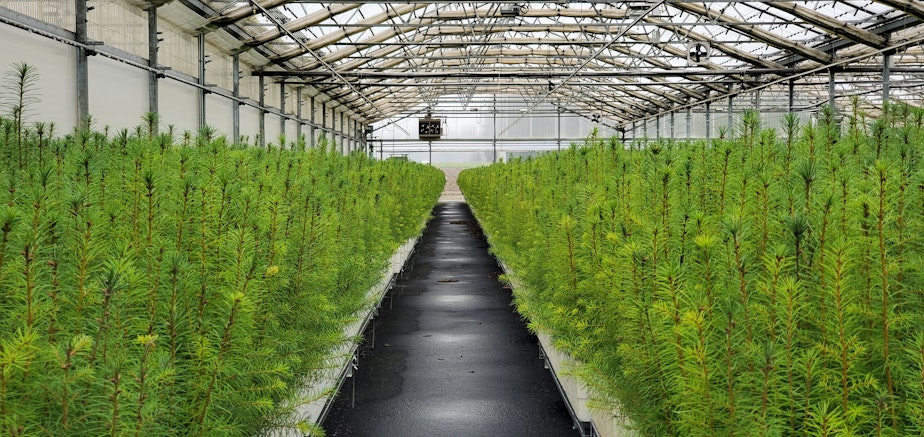
This requires a lot of sophisticated tracking on the nursery's part.
"In 15, 20 years, I could go out walking through the woods and say, 'Hey, I really like these trees that are growing here'," Morris explained. "And I can look into our geographic database. And I can figure out what date it was planted, what day the trees were harvested in the nursery, what day they were shipped, all the way back to when the seed was collected and where it was collected. Like the geographic coordinates of where the parent trees came from."
Sponsored
Assumption-crushing fact no. 1: trees aren't a one-size-fits-all kind of situation. When we talk about scaling up seed production to meet the growing demand, the state may be able to expand fir and ponderosa orchards, but woods-run seed collecting will still need to be done for the multitude of our local tree species.
Considering this immense, meticulous system, is it possible for the state to meet their expanding needs?
Taking to the skies
The state isn't the only one in this battle. The nursery is the largest public provider of seeds in the Northwest, but there are private companies helping too. And in our current era, it may not be surprising to hear that it's a tech company trying to solve our seeding problem.
"We've had helicopter seed collection, to collect a very large volume of seed," said Matthew Aghai, director of research and development for Seattle-based DroneSeed, and interim-general manager of Silvaseed. "But where we're at right now is that we're restarting, and looking at this as a technology company to see what we do to actually scale this in a sustaining way."
Sponsored
Assumption-crushing fact no. 2: trees are actually really hard to predict. You can send more foresters into trees or helicopters to collect more seeds, but it's very difficult to know if there will be more seeds to pick.
"Trees don't always create a bountiful crop each year of nice cones that are fertile," said Grant Canary, CEO of DroneSeed. "It's every two to seven years depending, and science is still determining why."
DroneSeed more recently found its way into the seed game when it purchased Silvaseed, a 130-year-old nursery and the largest private provider of seeds in the Northwest, in 2021. Prior to that, DroneSeed was focused on the other side of the supply chain: putting seeds in the ground. Using drones the size of a washing machine, the company aids with reforestation by strategically dropping scores of seeds over large swaths of lost forest.
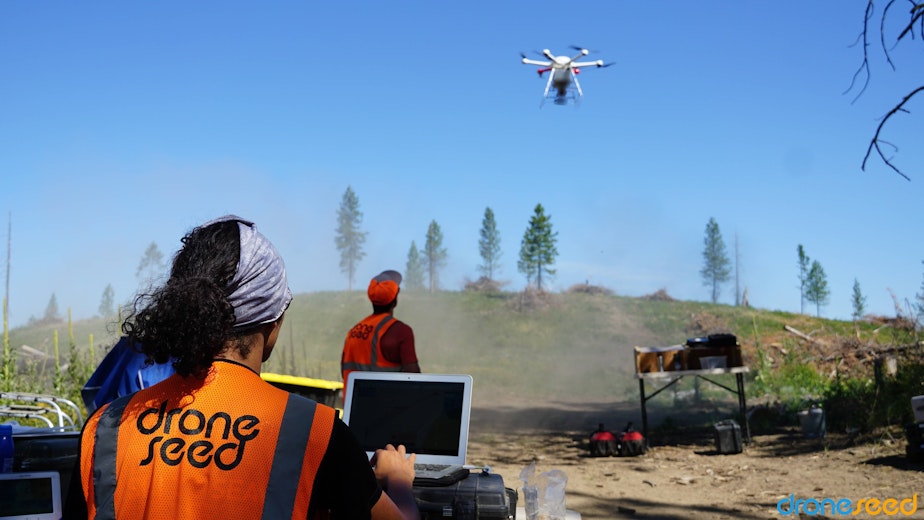
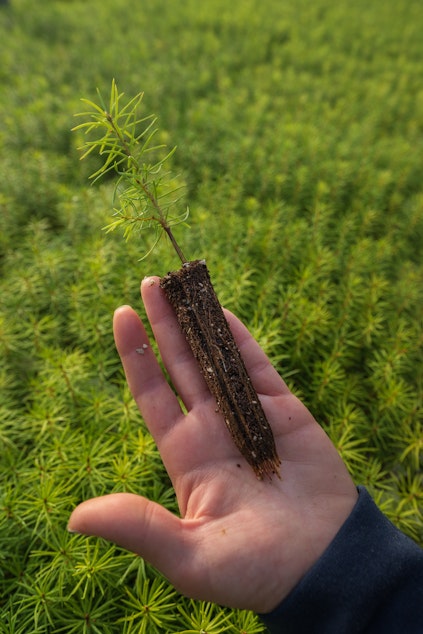
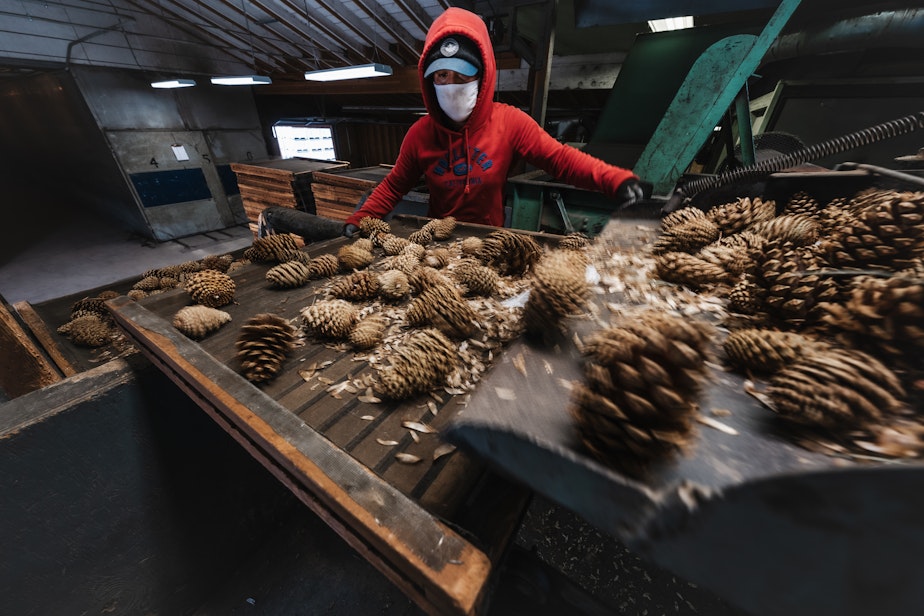
Unfortunately, there isn't a cure-all technological solution waiting in the wings for the current seed shortage. As an industry, seeding has actually shrunken over the past few decades, meaning there are fewer workers, nurseries, and experts to help ease the supply shortage. But luckily, there’s new attention on the issue now that our wildfires have gotten so daunting.
Sponsored
For both DroneSeed and the state nursery, the most salient solution is more, faster. The economy around our seeds needs more workers, more companies, and more inventory to keep up with our current reforestation debt. The best time to make more orchards was yesterday, but today’s a pretty good compromise. And if we don’t catch up? Other, invasive plants can creep in, effectively colonizing our forests and keeping trees from naturally recovering.
'A fun job sometimes, but mostly not'
Sam Steinshouer has mostly seen it all. He's worked as a firefighter, hand-potted seedlings, and planted future trees in our most damaged forests.
"It smells like a campfire that was put out a couple of weeks ago," Steinshouer described. "You spend your day slogging around, putting those trees into the ground, getting them in just the right spots, at the right depth, to ensure maximum survivability. I would say it's a fun job sometimes, but mostly not."
Steinshouer's job is to make sure our forests are recovering the way they should. If the forest nursery is collecting the seed, and DroneSeed is dropping them into the ground, Sam is the lifeguard on duty to make sure those trees stay alive.
For us humans, conceiving of forest recovery is an impatient task. A few years of burn scars across our landscape feels catastrophic. But in tree time, it's fractional. Steinshouer explained it takes 10 to 20 years after seedlings are planted to really see a true change in forest recovery.

"Forestry is kind of like a chapter book," Steinshouer said. "I can take a look at something that happened 20 years ago, or 40 years ago, or 60 years ago, and have an idea for generally what that natural process is. Personally, in my career, I'll be able to read a few chapters, but I'll probably never read that book from beginning to finish."
Steinshouer explained that "artificial restoration" — human-led reforestation — is critical for some areas, but many areas also recover naturally.
"I haven't seen large areas that have not reforested. It is usually limited in scope and scale," Steinshouer said.
Historically speaking, our forests have largely found a way to recover. Even with our current shortage, he mentioned that he's able to get what he needs when he needs it. A shortage on his end looks more like a shortfall of 100,000 seeds out of 500,000 — a sum that can be managed through lower density planting, or planting trees that fit the region but aren't the same stock type.
Steinshouer's hoping for a couple mild fire seasons for the backlog to catch up. But at least as of this winter, the shortage hasn't caused catastrophe in our forests.
In the end, forests have always endured great changes. But they also operate on a timescale that's almost inconceivable for us humans. Forests can and will recover from larger and larger wildfires — but it may take generations for us to see that recovery. If we want to continue using products made from trees, and if we want to continue enjoying our forests in the here and now, and if we want to protect our greatest producers of oxygen, then it will require renewed effort and attention toward one of the oldest pillars of life: our seeds.
"My general philosophy on it...having spent a good portion of my life working in the forests of Washington, is that time heals most, if not all wounds," Steinshouer said. "And to be careful and be prudent. As humans, we're stewards to manage."





